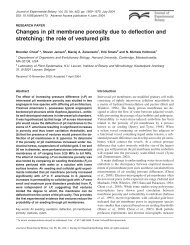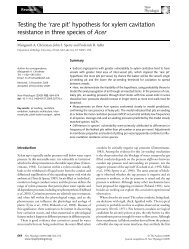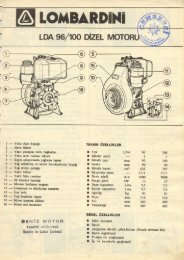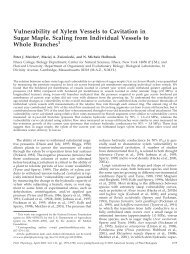View - ResearchGate
View - ResearchGate
View - ResearchGate
Create successful ePaper yourself
Turn your PDF publications into a flip-book with our unique Google optimized e-Paper software.
84 A. Vilagrosa et al.Fig. 3.9 Comparison of thewater potential at PLC 50(50 % loss of hydraulicconductivity) between rootsand shoots for 24 species.Methods for inducedcavitation were dehydration,air injection, andcentrifugation. (From:Martínez-Vilalta et al. 2002;Oliveras et al. 2003; Stoutand Sala 2003, McElroneet al. 2004; Pratt et al. 2007;Froux et al. 2005; Hukin et al.2005; Domec et al. 2006)PLC 50Stems (-MPa)14121086420R 2 = 0.730 2 4 6 8 10 12 14PLC 50 Root (-MPa)1:1range of habitats—from mesic to xeric—in Europe. The different thresholdsderived from the establishment of cavitation curves have been used for determiningthe distribution of plant species within (Maherali et al. 2006) and amongvegetation types (Maherali et al. 2004; Bhaskar et al. 2007). Moreover, the collapseof the hydraulic conductivity of the trunk or branches has been associatedwith some processes of forest decline (Corcuera et al. 2006; Hoffmann et al. 2011,Peguero-Pina et al. 2011a) or with the lack of seedling recruitment in Mediterraneanareas (Esteso-Martínez et al. 2006). These examples affirm the outstandingcontribution of vulnerability to drought induced cavitation in woody plants in theecology of ecosystems.Different papers (Tyree et al. 1993; Nardini and Salleo 2000; Barigah et al.2006) have shown that leaf hydraulic resistance constitutes the substantial componentof the whole shoot or plant hydraulic. However, how much the vascularpathway contributes to this resistance should be computed before discussing theimportance of leaf xylem cavitation in the SPAC dynamics. For Nardini et al.(2001), the main hydraulic restriction in the leaf lies in the non-vascular part of thepathway. The complexity of this mechanism is as high as in roots, in as far asmany processes are involved (Sack et al. 2004; Sack and Holbrook 2006),including changes in aquaporin activity (Martre et al. 2002). The partitioning ofthe hydraulic resistance of the whole leaf (R leaf ) into the vascular resistance(R xylem ) and the non-vascular resistance (R outside xylem ) has been a matter of studywith quite controversial results. Sack and Holbrook (2006) offered a good revisionof this matter, concluding that R xylem and R outside xylem are quite similar in magnitude,although some important variation in partitioning has been found whenspecies from different habitats have been compared.Changes in whole leaf hydraulic resistance due to cavitation in the complexxylem network of the leaf are well documented (Sack et al. 2004), and includediscussion on its importance as an ecophysiological process and explanations ofbiogeographic trends in leaf size (Scoffoni et al. 2011). This type of studyencompasses cavitation in the petiole (e.g., Cochard et al. 2000), midrib (Nardini
















